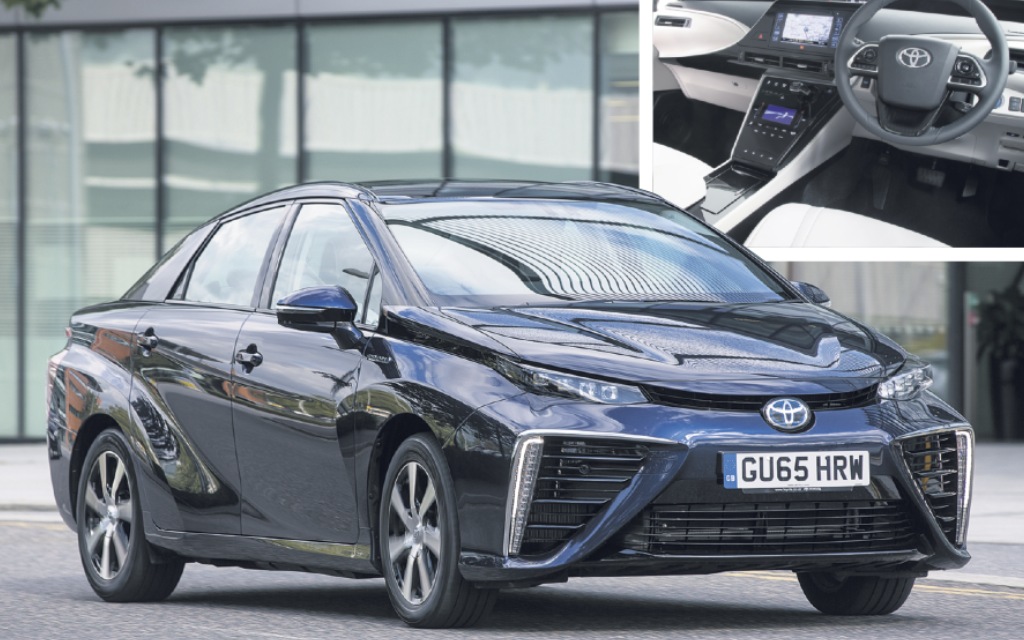The Toyota Mirai is the car you can buy – today – that only emits water

At a modernist house in North London – designed, built and rented out by one of the partners at Norman Foster’s firm – Toyota showed me the future of the car. It’s a long, funny-looking four-door contraption called the Mirai, with exaggerated rear wheel arches and a fittingly modernist front end. Other car companies talk about this stuff, occasionally showing off concepts. Toyota gets on with building them.
Make what you will of the looks, it’s still a momentous release: the world’s first mainstream, purpose-built production hydrogen fuel cell car. It doesn’t just have low emissions – it has no emissions. There isn’t even an exhaust: it doesn’t need one. The biggest worry Londoners will have is whether the drops of water that come out a pipe at the rear freeze.
“You can drink the water that comes out of it,” a Toyota spokesman assures me. Have you, I ask? He nods, seemingly none the worse for it. How does it taste? “Of nothing: it’s pure water, with no minerals or anything.” They’ll be selling Mirai Water in health food shops before you know it.
Futuristic it may be, but it’s also pretty simple technology, according to Toyota. “We’ve had the fuel cell ready for years,” shrugs the spokesman. “The difficult bit’s been making it cheap enough to build.” It’s still not quite there and Toyota will lose money on every Mirai, even at £66,000. Being the world’s biggest and most profitable car company, it’s not worried, having lost money on every Prius it made at first, but has now sold millions as the world increasingly agrees hybrid is the short-term answer to green motoring. Long-term, pure electric drive is the way to go.
Enter the magic of the fuel cell. Similar to an electric vehicle, batteries provide the power to the electric motor “engine” of the Mirai. But unlike an EV, you don’t have to plug it in – the fuel cell generates electricity on board, by mixing hydrogen from on-board tanks with air. Fill-ups take five minutes rather than eight hours and the range is 300 miles rather than barely a hundred.
The awkward bit is a lack of places to refuel it. There are thousands of petrol stations in the UK, but only a handful of hydrogen pumps. Londoners will have to visit Heathrow, or a trading estate in Wembley, to fill up their Mirai. Not ideal – but it’s a chicken and egg situation, says Toyota: someone had to make the first move.
I step out of the fancy house and into the Mirai. A plush, modern, tech-centric Japanese look, it’s clean, commanding and comfortable. Touch-sensitive surfaces, high-res displays; it’s a lovely place to save the world from. It only seats four, mind: those blast-proof carbon fibre-clad hydrogen tanks currently take up a lot of space.
So the bit I’ve been waiting for since watching Tomorrow’s World in the 1980s: driving a production-ready hydrogen-powered car. What’s the car of the future like? Well… just like an EV. An electric motor pushes you along, strongly and responsively: except here, there’s no range anxiety.
It’s comfortable, smooth and serene. The car tech of the next half-century feels incredibly normal. I contentedly crunch back up the drive to the fancy house. Cars to solve London’s pollution problems are here, and they’re lovely. But don’t expect to see it at a local Toyota dealer just yet – despite a £750 all-in fuel deal taking the sting out of that £66,000 list price (even hydrogen is included). Production will be a few-thousands in the first couple of years, and Britain will get about a dozen a year. But that’s how the Prius started, and now look at it.
Green early adopters, you need a Mirai. One day, all cars could be like this. The fact it’s a decent car in its own right (no G-Wiz lunacy here) is the icing on the cake. I’ll raise a glass of eau de Mirai to that.
Price: £66,000
0-62mph: 9.6 secs
Top speed: 111mph
Hydrogen range: 300 miles
★★☆☆☆ | Design
★★★☆☆ | Performance
★★★☆☆ | Practicality
★★★☆☆ | Value
